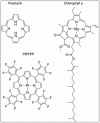Optical oxygen micro- and nanosensors for plant applications
- PMID: 22969334
- PMCID: PMC3435963
- DOI: 10.3390/s120607015
Optical oxygen micro- and nanosensors for plant applications
Abstract
Pioneered by Clark's microelectrode more than half a century ago, there has been substantial interest in developing new, miniaturized optical methods to detect molecular oxygen inside cells. While extensively used for animal tissue measurements, applications of intracellular optical oxygen biosensors are still scarce in plant science. A critical aspect is the strong autofluorescence of the green plant tissue that interferes with optical signals of commonly used oxygen probes. A recently developed dual-frequency phase modulation technique can overcome this limitation, offering new perspectives for plant research. This review gives an overview on the latest optical sensing techniques and methods based on phosphorescence quenching in diverse tissues and discusses the potential pitfalls for applications in plants. The most promising oxygen sensitive probes are reviewed plus different oxygen sensing structures ranging from micro-optodes to soluble nanoparticles. Moreover, the applicability of using heterologously expressed oxygen binding proteins and fluorescent proteins to determine changes in the cellular oxygen concentration are discussed as potential non-invasive cellular oxygen reporters.
Keywords: biosensors; dual-frequency phase‐modulation; endogenous sensor proteins; microsensors; nanosensors; oxygen sensor; phosphorescence quenching; plant science.
Figures



Similar articles
-
Potassium Sensitive Optical Nanosensors Containing Voltage Sensitive Dyes.Chimia (Aarau). 2015;69(4):196-8. doi: 10.2533/chimia.2015.196. Chimia (Aarau). 2015. PMID: 26668937
-
Self-referencing optrodes for measuring spatially resolved, real-time metabolic oxygen flux in plant systems.Planta. 2010 Oct;232(5):1087-99. doi: 10.1007/s00425-010-1234-6. Epub 2010 Aug 10. Planta. 2010. PMID: 20697740
-
Label-Free Optical Single-Molecule Micro- and Nanosensors.Adv Mater. 2018 Dec;30(51):e1801246. doi: 10.1002/adma.201801246. Epub 2018 Aug 2. Adv Mater. 2018. PMID: 30073717 Review.
-
Fiber-optic nanosensors for single-cell monitoring.Anal Bioanal Chem. 2005 Jun;382(4):918-25. doi: 10.1007/s00216-005-3256-7. Epub 2005 Jun 1. Anal Bioanal Chem. 2005. PMID: 15928944 Review.
-
Optical nanosensors for detecting proteins and biomarkers in individual living cells.Methods Mol Biol. 2005;300:383-401. doi: 10.1385/1-59259-858-7:383. Methods Mol Biol. 2005. PMID: 15657493 Review.
Cited by
-
Diverse applications of electronic-nose technologies in agriculture and forestry.Sensors (Basel). 2013 Feb 8;13(2):2295-348. doi: 10.3390/s130202295. Sensors (Basel). 2013. PMID: 23396191 Free PMC article. Review.
-
Sensors in a Flash! Oxygen Nanosensors for Microbial Metabolic Monitoring Synthesized by Flash Nanoprecipitation.ACS Sens. 2022 Sep 23;7(9):2606-2614. doi: 10.1021/acssensors.2c00859. Epub 2022 Sep 2. ACS Sens. 2022. PMID: 36053212 Free PMC article.
-
Simultaneous Fluorescence and Phosphorescence Lifetime Imaging Microscopy in Living Cells.Sci Rep. 2015 Sep 22;5:14334. doi: 10.1038/srep14334. Sci Rep. 2015. PMID: 26390855 Free PMC article.
-
Microphysiological flux balance platform unravels the dynamics of drug induced steatosis.Lab Chip. 2018 Aug 21;18(17):2510-2522. doi: 10.1039/c8lc00357b. Lab Chip. 2018. PMID: 29992215 Free PMC article.
-
Measuring ROS and redox markers in plant cells.RSC Chem Biol. 2021 Jun 29;2(5):1384-1401. doi: 10.1039/d1cb00071c. eCollection 2021 Oct 7. RSC Chem Biol. 2021. PMID: 34704044 Free PMC article. Review.
References
-
- Licausi F., Giorgi F.M., Schmälzlin E., Usadel B., Perata P., van Dongen J.T., Geigenberger P. HRE-type genes are regulated by growth-related changes in internal oxygen concentrations during the normal development of potato (Solanum tuberosum) Tubers. Plant Cell Physiol. 2011;52:1957–1972. - PubMed
-
- van Dongen J.T., Gupta K.J., Ramírez-Aguilar S.J., Araújo W.L., Nunes-Nesi A., Fernie A.R. Regulation of respiration in plants: a role for alternative metabolic pathways. J. Plant Physiol. 2011;16:1434–1443. - PubMed
Publication types
MeSH terms
Substances
LinkOut - more resources
Full Text Sources
Other Literature Sources

